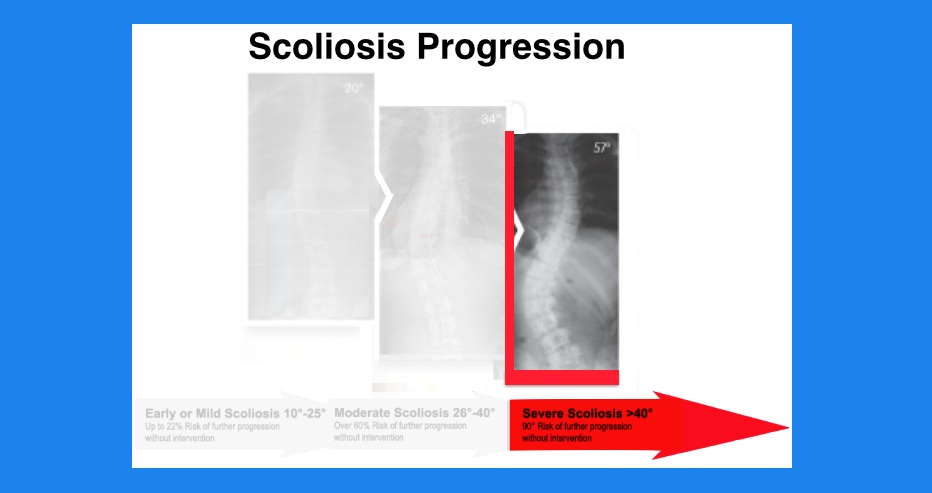Once a curve becomes greater than 40° it is considered to be a Severe Scoliosis and without intervention the risk of progression is 90%.
At this point patients will often experience pain and discomfort in the back and neck, headaches, poor balance, easily fatigued as well as digestive problems (due to ribs cage and spine collapsing on the lungs and internal organs). The rib hump is more pronounced and an “S” or “C” curve of the spine is readily apparent. As a result many patients will also have and anxiety related to a poor body image.
Comparison of Treatment Approaches
- Conventional Approach: Multilevel spinal surgery with placement of hooks and rods is almost always recommended
- Alternative Approach:In an attempt to halt the progression and avoid surgery an aggressive program of a combination of alternative treatments is recommended that utilizes the following:
-
Structural Reintegration
-
Postural Correction
-
Neuromuscular Re-Education of Movement Patterns
Surgery for Implantation of Rods -vs.- Natural Correction of Spinal Curves
Surgery should ALWAYS be the last resort, only utilized if everything else has failed.
When a scoliosis has progressed beyond 40° it is a very serious health concern and most often the orthopedic surgeon will recommend a multi-level spinal fusion surgery. Although surgical techniques for scoliosis have improved over the past several decades this surgery still remains one of the longest, most difficult and high risk surgeries performed by an orthopedic specialist.
The long term corrections of scoliosis with surgical intervention statistics were indeed grim. Often a second surgery for complete removal of the hardware after bony fusion has taken place is needed because of pain. Although surgery may be necessary if all other methods fail to halt the progression but it is often recommended BEFORE any alternative methods have been tried. The surgery is irreversible and once performed turns a manageable spinal deformity into a permanent spinal dysfunction that often results in chronic pain, disfigurement, and even long-term disability later in life.
Each year over one third of all spinal surgeries are performed on scoliosis patients with 20,000 Harrington rod implantation surgeries. Also, every year about 8,000 people who underwent this surgery in their youth for the correction of their scoliosis become legally defined as permanently disabled for life!
Because of the extremely invasive nature of the surgery, the high risk of complications and poor long term treatment outcomes many patients will only consider this as a last resort.
Unfortunately, once the scoliosis curves have progressed beyond 40 degrees the Conventional Approach offers the patient very limited choices, possibly rigid bracing and when that fails, the “big ticket item” surgery.
Because the stakes are so high our doctors evaluate each case of severe scoliosis and will decide on a case by case basis if they are a candidate for Alternative Non-surgical treatments. Finding a better solution in this case will require a great deal of patient commitment and before a patient is taken on a determination must be made if the patient is willing to do what it takes to avoid surgery.
If it is determined that the patient is indeed a qualified candidate for an Alternative Approach then they will place the patient in an aggressive, individualized, multifaceted course of care aimed primarily at halting the progression to avoid surgery. Our offices are equipped with specialized rehabilitation equipment for the specific purpose of providing the best available alternative treatment options for patients with curves of forty degrees or more.
Benefits of Alternative Care for Severe Scoliosis
- Avoid surgery
- Relieve pain
- Increase vital lung capacity and relieve organ pressure
- More energy
- Avoid permanent total disability later in life due to complications of the surgery

